What is SERP?
SERP is the ‘Search Engine Result Page’. Ok, that is just the full form. The search engine result page basically means the results that you see on your browser when you search for anything on the Internet. According to the stats, Google is number one when it comes to search engine ranking. So, let’s just stick to Google for now.
Since Google is number #1, obviously everyone wants to rank on the first page of Google search results. There are different parameters and tactics for that. But we will not get into it right now.
Let us only focus on SERP for the time being.
If you have noticed, whenever you search for anything on Google, you see a lot of other things on the page apart from the results. Ok, do not get confused. I am talking about the different types of search results and suggestions that Google shows. Like the snippets, video results, knowledge cards, news box, related questions, etc. These are the features of the SERP.
Let me take one at a time.
What is SERP Feature?

As the title says, this article is all about the in-depth knowledge of SERP features. I have already explained what it means and now I will talk about it one at a time. There are two types of results on the SERP – organic and paid.
Organic results are the ones that appear on the page without any paid promotions and that are in the closest proximity to the search query. And the SEO race that everyone wants to win today is landing in the organic results.
Now, if we talk about the SERP feature, these are the results that are not traditionally organic. There are basically four most common features:
- Rich Snippets – these types of results usually add an extra layer to the results. Like the reviews, stars, ratings, additional information, etc. In short, rich snippets shows some extra visual results compared to others.
- Paid Results – are the results that are paid for. The websites pay for selected keywords and if anyone searches for those keywords, their website would rank on top. Basically, it is how Google AdWords works.
- Universal Results – this feature actually combines different verticals and shows it as one result on the SERP. For eg, if the user is searching for let’s say Digital Marketing, the universal results will show all about it, including, news, maps, local businesses, etc.
- Knowledge graph – it enhances the results by giving additional knowledge about the query. This feature generally appears on the right side of the result page and on the top if browsing on mobile.
This was just a glimpse of what a SERP feature is and which are the most common ones. Now that we have a little understanding, let us dive a little deeper into the details and learn more about the other popular SERP features.
Here is the list of 15 Most Popular SERP Features
Being visible on the first page of Google is not all about SEO (Search Engine Optimization). Yes, it does play a major role, but you also have to take care of the way the algorithms and SERP features work.
According to the stats of 2019, many of the sites that ranked on the 1st page suffered from not receiving any clicks. Well, this is disturbing. But it had nothing to do with the way Google algorithms work. It was more of a result of how important SERP features are.
The user is getting all the answers he is looking for right on the first page with features like a knowledge panel and people also ask. Basically, Google is playing smart and now displays richer content and result as compared to the older style of typical blue links.
Now the question comes is how to make the most of these SERP features. Well, to know that keep reading till the end and you will get the answer.
The above-mentioned ones were the most common features. Now let us take a look at the most popular ones.
- Adwords (Top and Bottom):
These are basically the paid advertisements that appear at the top and/or bottom of the other search results. You can identify them with a blue-colored ‘Ad’ label on the left. Adword results have a high CTR compared to others.
The factors that decide if your paid result should rank on the top are your keywords and how close they are to the search query, your bid, etc.

2. Featured Snippets:
Making the search a little easier for the user, Google displays the precise information related to the query right on the result page itself. This user gets the answer on the page itself, without having to click any link. Though the information displayed here is derived from the web pages only and you can also see the URL of the page there.
Unlike Adwords, snippets do not push other organic results of the page. And therefore, it is also said to be at the 0 positions or 0 ranks. You can see the featured snippet just above the organic results and below the Adword (Top) result.

3. Image Pack:
This feature of the SERP displays the image results in a horizontal display. When you click on any of the images it opens up the Google Image search page. These results may appear anywhere on the page and have no fixed position.
The image pack feature especially comes in handy, if Google algorithms think that a visual result will be more appropriate and approachable to the search query.

To get to the image pack feature, make sure you use a descriptive file name for the image, descriptive alt text, optimized image size, readable URL and include the title attribute.
4. In-Depth Article:

You cannot always differentiate between in-depth article links and organic results. This feature usually appears for search queries that are not seeking a definite result. In short, if you are looking for something that is open to more than one interpretation, you will see in-depth article results by Google.
This feature is usually dominated by big authoritative publishers. They generally publish long content of around 2000-5000 words, use schema article markup, and authorship markup and have high-quality content.
5. Knowledge Card:
This feature can cover a major part of the result page. It contains information gathered from both human-edited semantic data and data extracted from the Google index. This type of feature usually appears where the search for big data is involved. And hence, it is difficult to feature your website here.
However, you can still try a hand at it by doing research about the keywords used to target such data, especially for the human edited semantic data like Wikipedia. This feature appears at the top of the result page.

6. Knowledge Panel:
Just like the knowledge card, the knowledge panel also known as Knowledge Graph extracts semantic data from Google index, human-edited pages, and private data partnerships. This feature appears on the top right side of the result page.
Getting to this feature is also difficult and the best you can do is evaluate the keywords and use them in your content. This feature is basically a piece of detailed information provided by Google about a specific person, place, thing, etc.

7. Local Pack:
This feature is a boon for the local business. The search queries which have words like, best … ‘near me’ or best …. in ‘location name’ will get the local pack feature. If the user is searching for anything local and you have stuffed enough keywords to be found locally, your link definitely has the chance of appearing here.
Your local SEO should be up to date if you want your link in the first five results.
8. Local Teaser Pack:

Like the local pack feature, this feature also shows results in a pack of three. The results for this feature are generally based on of course your local SEO, rankings, ratings, reviews, and the close proximity to the search query.
9. News Box:
This feature displays the trends and latest updates going on. Basically, the newsworthy content enters the news box feature. Unlike the organic results or other paid results, getting into the news box feature is totally different. It is more time-sensitive and transparent. This feature usually appears below 2-3 results with the heading ‘Top Stories’ or ‘In the News’.

10. Related Questions:
You might see this feature daily when you search anything on Google and might have used it also. But you probably did not know it was a SERP feature. Whenever you are browsing on Google for specific answers with questions as your search query, you get a column below which says ‘People Also Ask’.
This feature displays questions similar to what you have asked. To get through to this feature, keywords play a major role. Include question-oriented keywords in your title, meta description, etc.
11. Reviews:
Reviews, stars, and ratings play a vital role in your ranking on the SERPs. This feature is displayed between the URL and snippets. To get this feature one of the most important tactics is to have schema markup.

12. Shopping Results:
Shopping results are the paid results or product listing ads that specify information about a particular product with information like images and prices. Just like the Adwords, shopping results are paid results. It appears mainly at the top of the organic results like the image pack in a horizontal row.

13. Site Links:
If someone is specifically looking for a brand or searching for the exact domain, Google displays extended results up to 6-10 site links. The advantage of this feature is the CTR increases and the user can get to the page directly he is looking for. The possibility of featuring in site links increases if your site is already branded and receives heavy traffic and if the query is related to branded terms that you may be dealing in.

14. Tweet:
Google introduced a new feature in 2015, where it displayed tweets directly with the other organic search results. Though they are not organic but are displayed in the Tweet feature on the SERP definitely enhance the brand’s visual presence and awareness.

15. Video:
This feature is like the image pack, where Google will display some video results related to your search query. If you want to win this video feature, keywords are of course important, but more important is the use of video schema markup on your page.

Whether you are a local brand or a global giant, everyone wants to be on the front page, wants to rank #1 or even better #0. This is not something that cannot be achieved. All you have to do is get some expert guidance, understand the technicalities of how Google functions and roll up your sleeves to get it.
SEO is undoubtedly important, but it is not enough. There is a lot more than just ranking 1st on the SERP. Get displayed in the Google features and boast about winning the race.
Do not forget to share about your experience and if you get featured, do mention your victory in the comment box.
A Very Happy New Year to All..!!








Hi there to all, the contents present at this web page are truly
remarkable for people knowledge, well, keep up
the nice work fellows.
Thanks in support of sharing such a fastidious opinion, piece of writing is nice, thats why i have read it completely